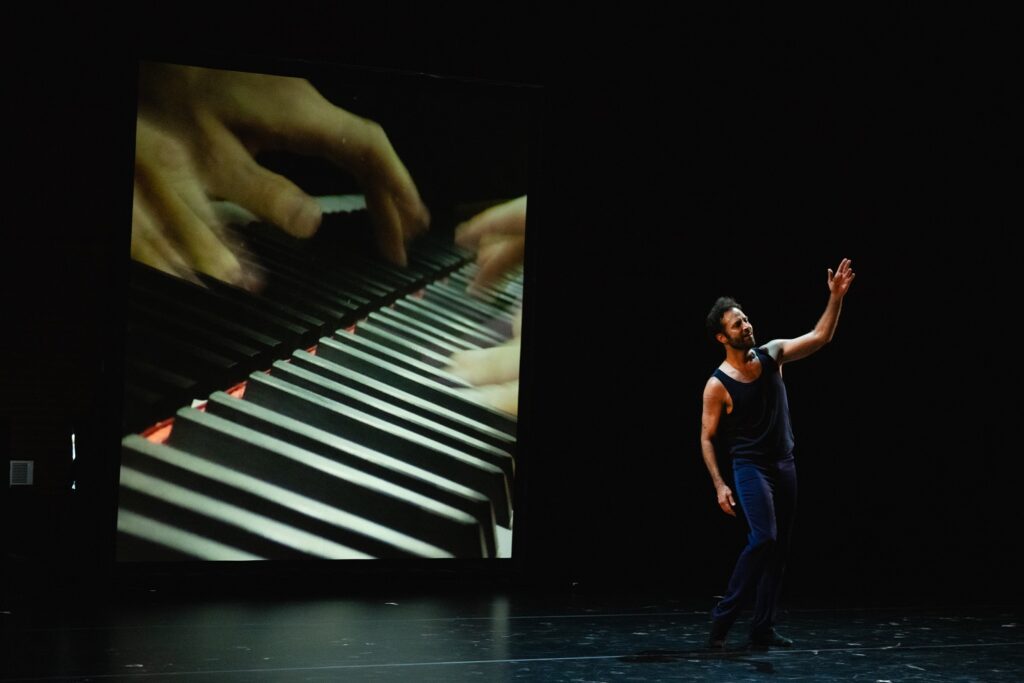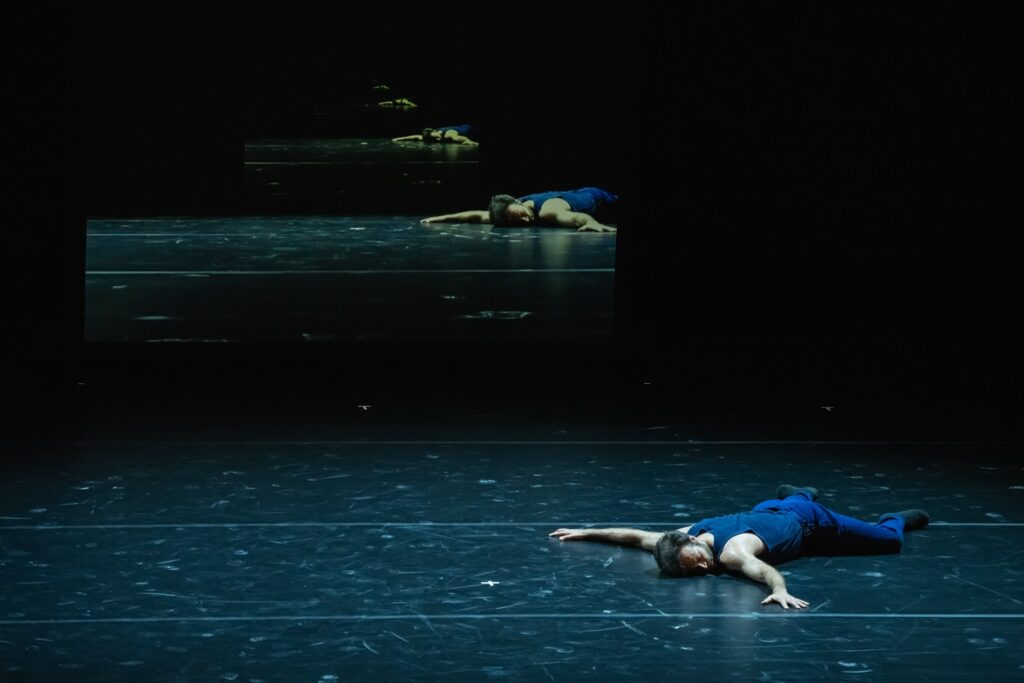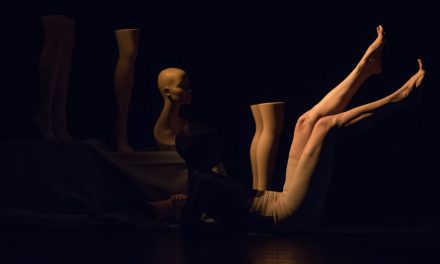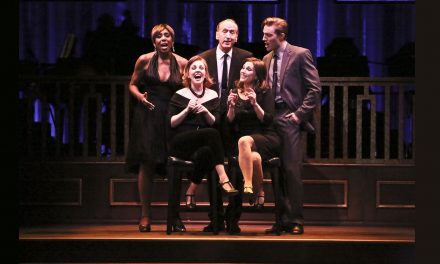Upon entering the space in the Walt Disney Concert Hall one’s attention goes directly to the stage where Mr. Benjamin Millepied is vigorously warming up while the house is open, thereby including the audience in his preparations for the evenings exertions and also serving to create an air of relaxed casualness to the event. He is sporting black sweats, a blue t-shirt and a white hoodie over it all and headphones, his iPhone on the piano handy for whatever music may be necessary. There are foot tracks across the stage extending from the rosin box upstage left to make patterns of feet equal to little crop circles on the floor. His routine consists of the usual stretches and degagés, small jetés, etc. And every now and then a section of impending choreography half-marked, half attempted.

Alexandre Tharaud at piano, Benjamin Millepied right in UNSTILL LIFE – Photo by Farah Sosa, for the LA Philharmonic.
Down stage right is the grand piano, upstage center is a large black screen at rest, down stage left is a small table in a tightly secluded area. This is the stage set for what becomes an entirely entertaining evening of magnificent musicality and playful camaraderie between Millepied and Alexandre Tharaud. The evening was indeed a dialogue between the two and took different forms as the evening progressed. After watching Millepied warm-up alone onstage, Tharaud enters with music in hand to great applause, Millepied defers to him joining in the applause for his pianist friend and taking none for himself. We begin.
The Rameau reminded me of the court dances of Louis XIV and Millepied’s choreography reflected this period and style. He was very precise and exacting in his movement, always hitting fifth position and if his port-de-bras was a little extravagant, it suited the manipulations of Tharaud at the keyboard. This piece exuded a kind of infectious joy in the movement, in merely being able to move, and it was clear that this is what the two artists share most. This was a delightful opening to their ‘conversation’ and created an air of playfulness which permeated the evening.
At one point a black and white film plays showing both artists as young boys pursuing their art, their passion. Interestingly, Tharaud as a boy ‘wanted to become a dancer’ while Millepied ‘dreamed of being a pianist.’ Irony abounds in the yin/yang of it all. Thankfully for us, they sorted it all out early on and the benefit was apparent this evening. The film has voice over from both of them describing their early years and how they embarked along their respective paths. It covers their meeting and instant connection. Central to their philosophy of dancing and playing is the music. What it brings out, what it demands, how it demands it and what gifts it bestows on those who delve ever deeper into its workings, its structure. A whole dissertation on music could be made by this one evening alone.
In the film they also talk about ageing as artists and what it means to get older in an art form such as Dance that necessarily requires great physical exertion as does playing Classical Piano. They opine about this and consider where each of them is at the age of Fifty. They mention what is no longer feasible for them and what is just at this point in their careers becoming clearer for them, the kind of clarity of purpose one can only get through vast experience. It has taken them both some fifty years in order to understand certain nuances of music. The comprehension of structure within music and how that structure informs the body dancing or the body playing was the central theme of the evening.

Alexandre Tharaud and Benjamin Millepied in UNSTILL LIFE – Photo by Farah Sosa, for the LA Philharmonic.
In the Bach, the movement was shortened, and arm movement became more jerky, abrupt. The port-de-bras clipped, and the body held slightly more rigid in order to make faster adjustments and turns. At one point, Millepied gets Tharaud up out of his seat behind the piano and they do a duet that is fun-loving and quirky with animated parallel arm and leg movements and humorous juxtapositions honoring their respective first loves. The evening was a tribute to musicality through the composers chosen to the forms visible onstage. Every aspect of the music was made manifest through video, dance, exposition, shadow play, camera work, and glorious playing.

UNSTILL LIFE – Benjamin Millepied with camera and Alexandre Tharaud at piano – Photo by Farah Sosa, for the LA Philharmonic.
The Beethoven Piano Sonata was a tour-de-force by Tharaud as it played his body and hands coming out of the instrument as if of its own accord. Millepied kept with it and in some moments focused on Tharaud’s playing with a hand-held live-feed camera projected on the screen upstage center. The double view enhanced the majesty of the music in a powerful display. At one point Millepied simply slides under the grand piano to lie on his back onstage at the Disney Concert Hall to listen enveloped by the great instrument. The best seat in the house indeed!

Benjamin Millepied (standing) and Alexandre Tharaud in UNSTILL LIFE – Photo by Farah Sosa, for the LA Philharmonic.
There was a movement that was repeated throughout the evening in many of the pieces and done by Millepied alone. He would raise his hands to cover his face one at a time, sometimes both together in a gratitude, or prayerful gesture, I do not know. I felt he was thankful for still being able to dance as he was trained to, for being able to perform to such incredible music, played by such an incredible artist as Tharaud, to share his Art, to partake of it, to be ‘at play in the fields of the Lord’ so to speak. Dancers can dance past thirty, forty, etc. There are many examples in the history of the artform and although not able to do some of the things that younger dancers can, older dancers pull focus in other ways. The muse has given them secrets it takes years to learn. Maturity in an artform cannot be taught to a twenty-year-old, it must be lived. Millepied proved it by tossing off double tours, tour jetés, and a string of sautés in attitude en Avant en tournant, alongside cabrioles, beats and clean fifths, with a lovely épaulement for punctuation.
The evening was a love-letter to musicality and longevity within two respectively inclusive artforms – and it was a joy to behold.
Benjamin Millepied – choreographer and dancer; Alexandre Tharaud – piano; and L.A. Dance Project, L.A. Phil. – producers.
The Program:
Rameau – Suite en La, RCT 5
Satie – Gnossienne No. 5, Piéces Froids: Danses de Travers, Gnoissienne 3, Lent
Bach – Partita No. 2 in C minor, BWV 826
Schubert – 4 Impromptus, Op. 90, D. 899
Beethoven – Piano Sonata No. 32 in C minor, Op. 111
For more information about LA Phil, please visit their website.
Written by Brian Fretté for LA Dance Chronicle.
Featured image: Benjamin Millepied (left) and Alexandre Tharaud in UNSTILL LIFE – Photo by Farah Sosa, for the LA Philharmonic.










